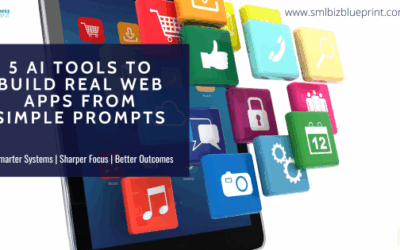Critical market dynamics that are shaping the business landscape in 2024.
It’s a transformative time for small businesses, and understanding these dynamics is more than just an exercise in trend-watching. It’s about identifying the shifts that directly impact your operations, customer engagement, and, ultimately your bottom line.
We’ll explore five key areas where these changes are most pronounced, offering insights and actionable strategies to help you adapt and thrive.
This is not just about keeping up; it’s about leveraging these insights to position your business as a leader in your industry.

#1 Digital Transformation Acceleration
In today’s digital-first world, embracing technology isn’t just an option; it’s necessary to stay competitive. For small businesses, this means more than just having a website or a social media presence. It’s about fundamentally integrating digital tools and platforms into every aspect of your operations, from customer service to inventory management.
The key here is to see technology as a lever for growth, not just a cost centre. Whether automating routine tasks to free up time for strategic thinking, leveraging e-commerce to expand your market reach, or using data analytics to understand customer preferences and personalise offerings, digital transformation can open new pathways for innovation and efficiency.
Consider this: a small, local retailer adopts an online ordering system. Suddenly, they’re not just a neighbourhood store but a business with the potential to reach customers nationwide.
Or a service provider who uses customer relationship management (CRM) software to track interactions and preferences, enabling them to offer highly personalised services that differentiate them from competitors.
The essence of digital transformation lies in its potential to redefine what your business can achieve. By thoughtfully integrating digital tools, you’re not just keeping pace with the market but setting new standards within your industry.
To effectively implement digital transformation in small business operations, consider the following steps:
Assess Current Digital Maturity
Begin by evaluating your current use of digital tools and technologies. Understand the gaps and areas for improvement in your operations, customer service, marketing, and sales processes.
Set Clear Objectives
Define what you want to achieve with digital transformation. This could range from improving customer experience to increasing operational efficiency and expanding your market reach. Ensure these objectives align with your overall business goals.
Identify Relevant Technologies
Research and identify the digital tools and solutions that align with your objectives. This could include cloud computing for flexibility and scalability, e-commerce platforms to broaden sales channels, CRM systems for better customer engagement or automation tools to streamline operations.
Develop a Step-by-Step Implementation Plan
Break down the transformation into manageable steps. Prioritise initiatives based on their potential impact and feasibility. Consider starting with quick wins that require minimal investment but offer tangible benefits.
Focus on Skills and Training
Digital transformation is as much about people as it is about technology. Invest in training your team to adapt to new tools and workflows. If necessary, consider hiring or partnering with digital experts.
Foster a Culture of Innovation
Encourage a mindset of continuous improvement and openness to change within your team. This cultural shift can significantly enhance the adoption and effective use of new technologies.
Measure and Adjust
Implement key performance indicators (KPIs) to measure the impact of digital transformation on your business. Use these insights to refine your strategy and make data-driven decisions.
By following these steps, small businesses can navigate the complexities of digital transformation and harness its benefits to drive growth and competitiveness.
#2 Increased Emphasis on Sustainability
As we navigate deeper into 2024, sustainability is no longer just a trend but a core component of business strategy, especially for small businesses like yours. This shift is driven by growing consumer demand for eco-friendly products and practices and increasing regulatory pressures to reduce environmental impact.
For small businesses, adopting sustainable practices is not just about compliance or marketing; it’s about future-proofing your business. It involves looking at your operations, supply chain, and product offerings through a green lens.
For example, reducing waste in your operations can lead to cost savings, while offering eco-friendly products can open up new markets and customer segments.
The challenge, however, lies in balancing the initial costs and efforts with the long-term benefits. It’s about making strategic choices that align with your business values and market position.
This could mean sourcing raw materials locally to reduce your carbon footprint, implementing energy-efficient workplace practices, or even rethinking your packaging to minimise waste.
What makes sustainability particularly compelling is the storytelling aspect. Consumers love to support brands that are part of the solution to environmental challenges. Sharing your sustainability journey with your customers can strengthen your brand’s reputation and customer loyalty.
For small businesses looking to adopt sustainable practices affordably and effectively, consider these strategies:
Reduce, Reuse, Recycle
Start with the basics by minimising waste in your operations. Implement recycling programs, reuse materials where possible, and reduce the use of non-recyclable resources. Simple steps like going paperless or double-sided printing can significantly impact over time.
Energy Efficiency
Invest in energy-efficient appliances and lighting, reducing energy consumption and lowering utility bills. Consider smart thermostats or energy management systems to optimise energy use in your business premises.
Sustainable Sourcing
Choose suppliers who prioritise sustainability in their operations. This might involve sourcing locally to reduce transportation emissions or selecting products made from recycled or renewable materials.
Eco-friendly Products and Packaging
Offer environmentally friendly products, and consider reducing packaging or using biodegradable or recyclable materials. This appeals to eco-conscious consumers and can reduce your environmental footprint.
Encourage Sustainable Transportation
For businesses that rely on transportation or delivery, consider fuel-efficient vehicles, electric vehicles, or bike delivery options in urban areas. Encourage employees to use public transport, carpool, or cycle to work by offering incentives.
Green Certifications
Pursuing relevant environmental certifications can help guide your sustainability efforts and be a powerful marketing tool to attract customers.
Community Engagement and Education
Engage with your local community on environmental initiatives. Host workshops or create content that educates your customers on the importance of sustainability and how your business contributes.
By implementing these strategies, small businesses can make meaningful strides towards sustainability without incurring significant costs, enhancing their brand value and customer loyalty while contributing positively to the environment.

#3 Changing Consumer Behaviors and Expectations
Consumer behaviour has seen significant shifts, particularly after recent global events. In 2024, these changes will be more pronounced, with consumers expecting more from the brands they choose and how they interact with them.
For small businesses, understanding and adapting to these evolving expectations is not just about survival; it’s about thriving in a competitive marketplace.
Today’s consumers seek more than just a product or a service; they seek an experience that aligns with their values and lifestyles. This includes a seamless online shopping experience, transparent and sustainable business practices, and personalised customer service.
For instance, a small café can leverage a mobile ordering app to reduce wait times, offer ethically sourced products, and use customer data to personalise promotions and rewards.
Moreover, the rise of social media and review platforms has empowered consumers like never before. They can voice their opinions, share their experiences, and influence others in real time. This means that every interaction, every purchase, and every customer review can significantly impact your business reputation and growth.
Small businesses must be agile, customer-centric, and innovative to navigate this dynamic. It’s about engaging with your customers where they are, listening to their feedback, and continuously improving your offerings based on their needs and preferences. Whether adopting new technologies, embracing social media marketing, or enhancing your customer service, the goal is to create a customer experience that meets and exceeds expectations.
Small businesses can leverage technology to meet new consumer expectations for personalisation and online services through various innovative strategies:
Customer Relationship Management (CRM) Systems
Utilise CRM software to collect and analyse customer data, enabling you to understand their preferences, purchase history, and behaviours. This information can tailor communications, offers, and services to individual customer needs, enhancing the personalisation of your interactions.
E-commerce Platforms
Invest in a robust e-commerce platform that offers a seamless, user-friendly shopping experience. Features like personalised product recommendations, easy navigation, and secure payment options can significantly enhance the online shopping experience for your customers.
Social Media Engagement
Use social media platforms to connect with your audience more personally and directly. Engaging content, interactive posts, and prompt responses to comments and messages can help build a community around your brand and personalise the customer experience.
Email Marketing Automation
Implement email marketing tools that allow for segmentation and automation. Sending targeted emails based on customer interests, behaviours, and past purchases can make your communications more relevant and personal.
Chatbots and AI
Deploy chatbots on your website or social media channels to provide instant customer service. AI-powered chatbots can handle a range of queries, offer personalised shopping advice, and improve customer engagement outside regular business hours.
Mobile Apps
Develop a mobile app that offers unique functionalities like loyalty programs, in-app purchases, and personalised notifications. An app can enhance the customer experience by providing convenience and added value.
Analytics and Insights
Use analytics tools to gain insights into customer behaviour on your website and social media channels. This data can help you make informed decisions about better catering to your customers’ needs and preferences.
By adopting these technologies, small businesses can offer personalised and efficient online services that meet the evolving expectations of today’s consumers, thereby enhancing customer satisfaction and loyalty.
#4 The Rise of Remote Work Culture
The rise of remote work culture marks a significant shift in how businesses operate, particularly for small businesses traditionally relying on in-person interactions. This transformation isn’t just about where and how we work, collaborate, and maintain a cohesive team dynamic.
In 2024, embracing this shift can be a strategic advantage for small businesses.
For small business owners, the challenge lies in maintaining productivity, fostering team spirit, and ensuring effective communication in a remote or hybrid environment. However, this new work culture also presents opportunities to access a broader talent pool, reduce overhead costs, and offer employees a better work-life balance, leading to higher job satisfaction and retention.
Leveraging technology is key to making remote work successful. Tools like video conferencing, cloud-based project management software, and secure file-sharing platforms can help teams stay connected and collaborate effectively, regardless of physical location.
Regular virtual meetings, team-building activities, and clear communication channels help maintain a sense of community and shared purpose.
Moreover, small businesses can adopt flexible work policies that accommodate individual needs while meeting business objectives. This might include flexible hours, results-oriented work environments, and providing necessary resources and support for home offices.
Embracing remote work culture isn’t just about adapting to a trend; it’s about recognising the evolving expectations of the workforce and leveraging these changes to build a more adaptable, resilient, and competitive business.
To effectively manage remote teams, small businesses can employ several strategies:
Clear Communication
Establish clear communication channels using tools like Slack, Microsoft Teams, or email. Regular updates, check-ins, and feedback sessions help keep everyone aligned and informed.
Use of Collaboration Tools
Implement project management and collaboration tools such as Trello, Asana, or Monday.com to keep projects on track, assign tasks, and monitor progress transparently.
Set Clear Expectations and Goals
Clearly define roles, responsibilities, and expectations for each team member. Setting specific, measurable, achievable, relevant, and time-bound (SMART) goals can help maintain focus and productivity.
Regular Virtual Meetings
Schedule regular team meetings and one-on-one check-ins via video conferencing to maintain a sense of connection and address any issues promptly.
Foster a Strong Company Culture
Even remotely, it’s crucial to cultivate a positive and inclusive company culture. Virtual team-building activities, informal catch-ups, and recognition of team and individual achievements can contribute to a sense of belonging and morale.
Encourage Work-Life Balance
Recognize the challenges of remote work, such as the blurring of work-life boundaries. Encourage your team to take regular breaks, set work hours, and maintain a healthy work-life balance.
Offer Training and Support
Provide your team with the necessary training and resources to work from home effectively. This could include access to online courses, technical support, and ergonomic home office equipment.
Embrace Flexibility
Understand that remote work offers flexibility, and be open to accommodating different working hours and arrangements as long as the work gets done and meets quality standards.
By implementing these strategies, small businesses can navigate the challenges of managing remote teams, ensuring productivity, engagement, and a cohesive work culture despite the physical distance.

#5 Intensifying Competition and Market Saturation
In 2024, the business landscape for small businesses is more competitive than ever.
Technological advancements and the ease of starting new ventures have led to market saturation in many sectors. For small business owners, this means that standing out and capturing the attention of your target audience requires more than just offering a quality product or service; it necessitates a strategic approach to differentiation and value creation.
The key to thriving in a saturated market is understanding your unique value proposition (UVP). What can your business offer that no one else can?
This could be exceptional customer service, a unique brand story, innovative product features, or a commitment to sustainability. Your UVP should resonate with your target audience and be communicated clearly in all your marketing efforts.
Moreover, niche marketing has become increasingly important in a crowded marketplace. By focusing on a specific market segment, you can tailor your offerings to meet that group’s unique needs and preferences, reducing the competition and increasing your chances of building a loyal customer base.
Leveraging technology and data analytics can also provide a competitive edge. Understanding consumer behaviour, preferences, and trends enables you to make informed decisions about product development, marketing strategies, and customer experience enhancements.
Finally, fostering partnerships and collaborations with other businesses can open up new opportunities for growth and differentiation. Whether it’s co-branding efforts, joint ventures, or strategic alliances, these partnerships can help you reach new audiences and add value to your offerings.
In the face of intensifying competition and market saturation, the ability to adapt, innovate, and focus on what makes your business unique is more crucial than ever.
By embracing these strategies, small businesses can carve out their own space in the market and build a sustainable path to success.
Small businesses can identify and capitalise on niche markets through a series of strategic steps:
Conduct Market Research
Use market research to identify underserved or overlooked segments within a broader market. Tools like surveys, focus groups, and market analysis reports can provide insights into consumer needs and gaps in the current market offerings.
Analyse Competitors
Study your competitors to understand their strengths and weaknesses. This can help you identify opportunities they may have missed and areas where you can differentiate your offerings.
Understand Your Strengths
Assess your business’s unique strengths and capabilities. This could be specialised knowledge, unique skills, or specific resources that can serve a particular market segment effectively.
Define Your Target Audience
Based on your research, clearly define your target niche market’s specific characteristics, needs, and preferences. The more detailed your understanding, the better your offerings can be tailored to their specific needs.
Test Your Offerings
Before fully committing to a niche market, test your product or service with a small target audience segment. This can provide valuable feedback and help you refine your offerings to meet the niche market’s needs better.
Customize Your Marketing Strategy
Develop a marketing strategy that speaks directly to your niche audience. Use language, channels, and messaging that resonate with them. This personalised approach can help you connect strongly with your target market.
Build Expertise and Authority
Position your business as a leader or expert in your niche market. This can involve creating educational content, participating in industry forums, or offering specialised services demonstrating your expertise.
Leverage Customer Feedback
Continuously collect and analyse feedback from your niche market to improve your offerings and stay ahead of evolving needs and trends within the niche.
By following these steps, small businesses can successfully identify lucrative niche markets and tailor their offerings to meet the unique needs of these specific segments, thereby reducing competition and increasing their chances of success.
In the fast-evolving business environment of 2024, small businesses face a landscape filled with challenges and opportunities. Navigating the dynamics of digital transformation, sustainability, changing consumer behaviours, remote work culture, and intensifying competition requires adaptability, innovation, and strategic foresight.
By understanding these key market dynamics and implementing targeted strategies, small businesses can survive and thrive, establishing themselves as leaders in their respective fields.
Embracing digital tools, adopting sustainable practices, responding to new consumer expectations, leveraging the benefits of remote work, and identifying niche markets are not just survival tactics; they’re growth strategies that can set your business apart in a crowded marketplace.
The journey ahead may be complex, but with the right approach, 2024 can be a year of significant opportunity and success for small businesses ready to adapt and innovate.
FAQs
Q1 What are the key market dynamics small businesses face in 2024?
A1 Small businesses in 2024 need to navigate digital transformation, sustainability demands, evolving consumer expectations, the shift towards remote work culture, and increasing competition.
Q2 How can small businesses effectively implement digital transformation?
A2 Small businesses can effectively embrace digital transformation by assessing current digital use, setting clear goals, choosing the right technologies, and providing training and support to staff.
Q3. Why is sustainability important for small businesses now?
A3 Sustainability is crucial due to the growing consumer and regulatory demand for eco-friendly practices, which can lead to cost savings and new market opportunities for small businesses.
Q4 What changes in consumer behaviour should small businesses anticipate?
A4 Businesses should prepare for increased online engagement, a preference for personalised experiences, and a greater emphasis on brand values aligning with personal beliefs.
Q5 How can small businesses adapt to the remote work culture?
A5 Adopting flexible policies, utilising collaboration tools, and maintaining clear communication can help small businesses thrive in a remote work environment.
Q6: What strategies can small businesses use to stand out in a saturated market?
A6 Focusing on niche markets, leveraging unique value propositions, and enhancing customer experience can help small businesses differentiate themselves.
Q7: Where can small businesses find resources to help with these challenges?
A7 Business owners can seek guidance from industry associations, digital transformation consultants, sustainability experts, and marketing professionals to navigate these challenges.




